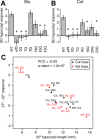PIF4 and ELF3 Act Independently in Arabidopsis thaliana Thermoresponsive Flowering
- PMID: 27564448
- PMCID: PMC5001698
- DOI: 10.1371/journal.pone.0161791
PIF4 and ELF3 Act Independently in Arabidopsis thaliana Thermoresponsive Flowering
Abstract
Plants have evolved elaborate mechanisms controlling developmental responses to environmental stimuli. A particularly important stimulus is temperature. Previous work has identified the interplay of PIF4 and ELF3 as a central circuit underlying thermal responses in Arabidopsis thaliana. However, thermal responses vary widely among strains, possibly offering mechanistic insights into the wiring of this circuit. ELF3 contains a polyglutamine (polyQ) tract that is crucial for ELF3 function and varies in length across strains. Here, we use transgenic analysis to test the hypothesis that natural polyQ variation in ELF3 is associated with the observed natural variation in thermomorphogenesis. We found little evidence that the polyQ tract plays a specific role in thermal responses beyond modulating general ELF3 function. Instead, we made the serendipitous discovery that ELF3 plays a crucial, PIF4-independent role in thermoresponsive flowering under conditions more likely to reflect field conditions. We present evidence that ELF3 acts through the photoperiodic pathway, pointing to a previously unknown symmetry between low and high ambient temperature responses. Moreover, in analyzing two strain backgrounds with different thermal responses, we demonstrate that responses may be shifted rather than fundamentally rewired across strains. Our findings tie together disparate observations into a coherent framework in which multiple pathways converge in accelerating flowering in response to temperature, with some such pathways modulated by photoperiod.
Conflict of interest statement
The authors have declared that no competing interests exist.
Figures





Similar articles
-
Gibberellin driven growth in elf3 mutants requires PIF4 and PIF5.Plant Signal Behav. 2015;10(3):e992707. doi: 10.4161/15592324.2014.992707. Plant Signal Behav. 2015. PMID: 25738547 Free PMC article.
-
Natural variants of ELF3 affect thermomorphogenesis by transcriptionally modulating PIF4-dependent auxin response genes.BMC Plant Biol. 2015 Aug 14;15:197. doi: 10.1186/s12870-015-0566-6. BMC Plant Biol. 2015. PMID: 26269119 Free PMC article.
-
The B-BOX protein BBX21 suppresses thermosensory growth under short- and long-day photoperiods by distinct mechanisms.Plant J. 2025 Jul;123(1):e70345. doi: 10.1111/tpj.70345. Plant J. 2025. PMID: 40653983
-
Molecular and functional dissection of EARLY-FLOWERING 3 (ELF3) and ELF4 in Arabidopsis.Plant Sci. 2021 Feb;303:110786. doi: 10.1016/j.plantsci.2020.110786. Epub 2020 Dec 3. Plant Sci. 2021. PMID: 33487361 Review.
-
Regulation of PIF4-mediated thermosensory growth.Plant Sci. 2020 Aug;297:110541. doi: 10.1016/j.plantsci.2020.110541. Epub 2020 May 30. Plant Sci. 2020. PMID: 32563452 Review.
Cited by
-
How Do Arabidopsis Seedlings Sense and React to Increasing Ambient Temperatures?Plants (Basel). 2025 Jan 16;14(2):248. doi: 10.3390/plants14020248. Plants (Basel). 2025. PMID: 39861601 Free PMC article.
-
Tracing the Evolutionary History of the Temperature-Sensing Prion-like Domain in EARLY FLOWERING 3 Highlights the Uniqueness of AtELF3.Mol Biol Evol. 2024 Oct 4;41(10):msae205. doi: 10.1093/molbev/msae205. Mol Biol Evol. 2024. PMID: 39391982 Free PMC article.
-
Hysteresis in PHYTOCHROME-INTERACTING FACTOR 4 and EARLY-FLOWERING 3 dynamics dominates warm daytime memory in Arabidopsis.Plant Cell. 2022 May 24;34(6):2188-2204. doi: 10.1093/plcell/koac078. Plant Cell. 2022. PMID: 35234947 Free PMC article.
-
Plant growth promotion by the interaction of a novel synthetic small molecule with GA-DELLA function.Plant Direct. 2022 Apr 26;6(4):e398. doi: 10.1002/pld3.398. eCollection 2022 Apr. Plant Direct. 2022. PMID: 35492684 Free PMC article.
-
Variability in a Short Tandem Repeat Mediates Complex Epistatic Interactions in Arabidopsis thaliana.Genetics. 2017 Jan;205(1):455-464. doi: 10.1534/genetics.116.193359. Epub 2016 Nov 18. Genetics. 2017. PMID: 27866166 Free PMC article.
References
MeSH terms
Substances
Grants and funding
LinkOut - more resources
Full Text Sources
Other Literature Sources
Molecular Biology Databases
Miscellaneous

